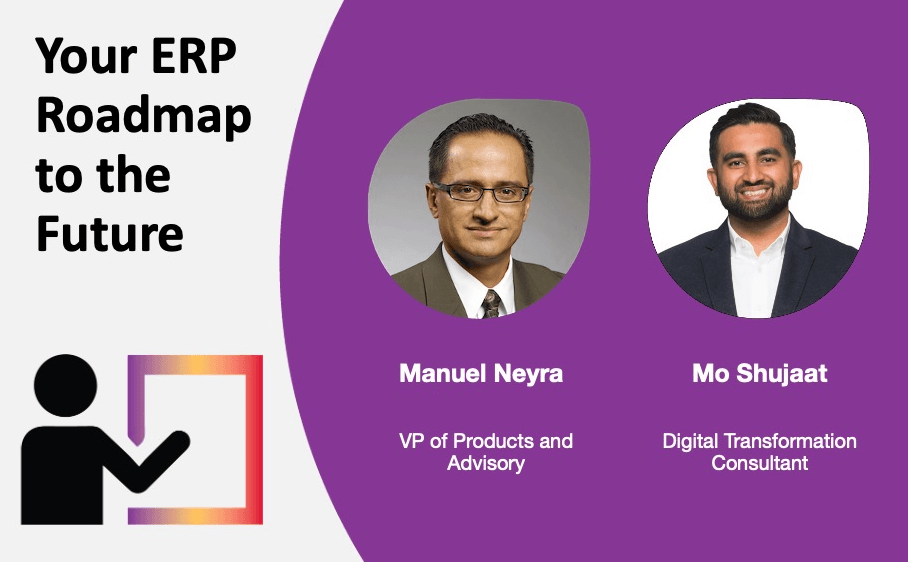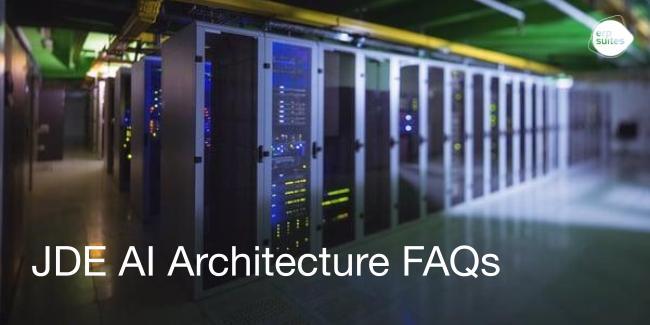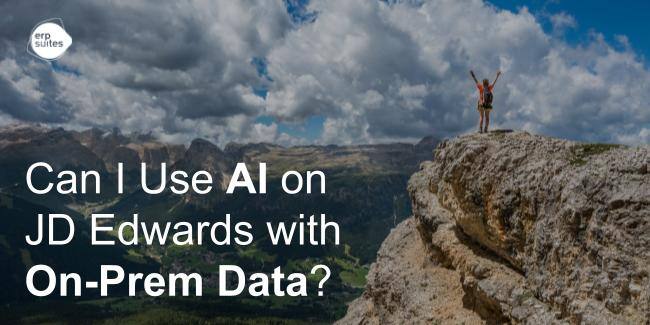3 Ways to Maximize Your Company's ERP Investment
November 9th, 2023
4 min read

In the fast-paced world of business with razor-thin margins and fierce competition, taking full advantage of everything your ERP has to offer is of the utmost importance. An ERP system is not just a software solution; it’s a strategic asset that has the potential to drive your organization’s success in multiple ways.
Read on for invaluable insights from the ERP Suites Advisory Team on how to better leverage your existing ERP by taking a closer look at your involved costs, the tools and technology being utilized, and opportunities for business process innovation.
1. Cost Efficiency: Optimizing Your ERP Investment
First things first, you’re going to want to assess your current associated ERP costs. The most common costs are related to licensing, maintenance, and opportunity.
Licensing and subscription fees
With any cloud versus on-premises solution, you will always hit a point where on-prem is a lower TCO (total cost of ownership.) Cloud bills itself as cost-competitive at the outset, which is how many customers are lured in to make the switch.
Promised low introductory rates that are too good to be true, customers undergo the process of switching hosting to take advantage of those rates. Alas, they are just too good to be true – after the first two years, rates typically soar for licensing and other fees.
With size remaining static, looking at the traditional perpetual license model versus cloud subscription model, there comes a point of diminishing returns, where the customer starts paying for software over again at two and three times the rate three years in. Essentially, the customer has already paid everything they would have paid for perpetual licensing, including support.
Opportunity costs
In a traditional on-premises ERP, customers would implement and then follow a pattern of sustaining their services. They would patch but they wouldn’t adopt any of the new capabilities the vendor was delivering. With Cloud, about 75% of those new features are forced every quarter to accept the new options. That forces the issue – if a customer is not ready for those new releases, and doesn’t value that, then they’re paying significantly more over time for their cloud ERP.
Support
Of course, maintenance of on-premise ERP, such as JD Edwards, has its own attendant costs, too. Labor hours should be considered when it comes to operating your ERP for any kind of break/fix types of scenarios that may arise. It’s also important to budget in training time costs – in order to perform the break/fix scenarios above, your team needs to be as up-to-date on the software as possible.
2. Utilize the Tools and Technology
Compared to other ERP vendors, JD Edwards is far more pliable. You’re not locked into a prescriptive and restrictive system, and you can get much more flexibility with your product.
Orchestrator’s automation capabilities
One of JDE’s greatest assets is certainly Orchestrator. A low-code/no-code robotic process automation (RPA) tool built into JD Edwards, you can create, automate, and customize business processes and workflows through Orchestrator, bypassing the need for extensive coding or development skills.
Tasks such as data entry, approvals, notifications, and integrations with external systems are automated with Orchestrator. By using this innovative JDE tool, companies can reduce errors that might occur manually otherwise, accelerate decision-making for more efficiency, and improve overall operational flow. Orchestrator’s flexibility and adaptability make it a valuable tool for businesses looking to harness the benefits of automation in a rapidly evolving digital landscape.
Native built-ins
Anytime a tool is built to be compatible with an ERP makes for an easier user experience. Perhaps one of the best native tools for use with JD Edwards is the Oracle Analytics Cloud or OAC. With OAC, your company can analyze, visualize, and gain insights from your own data, no matter its original source or format, by using self-service analytics tools and advanced data visualization capabilities. Companies are then able to make data-driven decisions that lead to improved business performance.
Value of AIS
The value of the REST AIS (Representational State Transfer Application Interface Services) in the JD Edwards system cannot be overstated. It provides a standardized way for external applications and systems to interact with JD Edwards, which then enables data retrieval, updates, and integration with other software.
In the past, providers had to undertake an almost-Herculean effort with creating individual business processes one at a time – a time-consuming and labor-intensive process. With JD Edwards, the system has been architected and enhanced to make everything that is currently available and will be built in the future automatically available on the AIS. That can then be leveraged for any kind of integration, automation, whatever other use cases exist in that space.
Content Experience Cloud
Are you familiar with the attachment capability that JD Edwards has? Content experience cloud is that on hyperdrive. It’s a full document and artifact management opportunity with indexing and the ability to be accessed from multiple endpoints. It’s searchable from not only the app but centrally in other ways with multiple access points open to users via those attachments.
3. Innovate Business Processes
Transitioning to a new ERP requires you to revisit or readapt or change your processes. If you stay on JD Edwards, you have the tools to transform your processes, make them more efficient and streamlined, explore possibilities, and get more ROI and value out of it without having to undergo the exhaustive effort of transitioning to a new ERP. Basically, a new ERP isn’t the only way to innovate your processes.
Evolution and Maturation
As your business grows, change is bound to happen. Your processes and operations need to change to operate effectively at that next size. JD Edwards can adapt with your business as it grows. Kind Bar is a classic example of a JD Edwards user that went from $150 million in revenue to over $1 billion in just three years. That growth happened in a short timeline, running with JD Edwards all the while, which allowed them to adapt with their changing business processes.
Orchestrator innovation possibilities can be transformative
Business process innovation is enabled within JD Edwards thanks to its standard architecture. This is another place where Orchestrator shows up – through orchestrations, processes can be further innovated, extended, and transformed.
Edge Apps
Within the broad ERP that is JD Edwards, specialized capabilities also exist. Not every customer will need these functions, but when they do, it’s more easily done with JD Edwards than other traditional ERPs because of that option.
Or let’s say a customer wants a best of breed HCM solution. JD Edwards is good at HR, but payroll is so-so. To get a best of breed HCM, they can pair JDE HR with payroll from Oracle or another alternative. If they need something more sophisticated, they don’t need to switch ERPs, they can just transition a portion of it to an Edge app.
Mergers and Acquisitions
Having a strong ERP like JD Edwards that has so many capabilities makes it easier when it comes to mergers and acquisitions. You won’t have to go through the rigamarole of having to bring your M&A onto a different ERP and then do a financial consolidation program. Instead, JD Edwards likely has the capabilities to support that business in a way where you can link financials.
So. How can we help you? Whatever it is, let’s discuss it. Contact us here.
Topics:



.png?width=650&height=325&name=Blog%20Images%202_1%20(4).png)
.png?width=650&height=325&name=Blog%20Images%202_1%20(5).png)
.png?width=650&height=325&name=Blog%20Images%202_1%20(3).png)
.png?width=650&height=325&name=Blog%20Images%202_1%20(2).png)
.png?width=650&height=325&name=Blog%20Images%202_1%20(1).png)
.png?width=960&height=540&name=Blog%20Images%20(96).png)

.png?width=960&height=540&name=Blog%20Images%20(90).png)
.png?width=960&height=540&name=Blog%20Images%20(88).png)
.png?width=960&height=540&name=Blog%20Images%20(87).png)
.png?width=960&height=540&name=Blog%20Images%20(86).png)
.png?width=960&height=540&name=Blog%20Images%20(85).png)
.png?width=960&height=540&name=Blog%20Images%20(83).png)
.png?width=960&height=540&name=Blog%20Images%20(82).png)
.png?width=960&height=540&name=Blog%20Images%20(80).png)